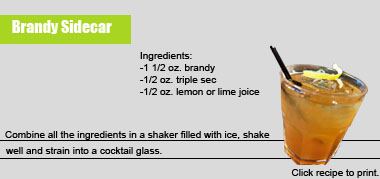Tradition
Though The Old Fashioned and other bars and restaurants work to introduce brandy to a new generation of Wisconsinites and out-of-state brandy novices, the drink maintains deep family roots statewide. Bonni Falkner, an Eau Claire native, remembers brandy as a staple in her childhood home–J. Bavet label brandy in particular.
“As I grew up, there was always brandy in the house,” Falkner says. “My dad used to tell my mom it was because ‘Bonni might want a drink when she stops down!’ Yeah right! Dad wanted to sip brandy and blamed it on me.”
Falkner’s family used brandy in another manner as well–as a form of medicine.
“In our house, anyone who got a sniffle was given a hot toddy and told to plug our noses and drink it,” Falkner says. “Didn’t matter what age. It was cheaper than cold medicine.”
The recipe for The Old Fashioned’s second best selling drink comes straight from Watertown, Wis. Compliments of De Bolt’s grandmother, who prepared the drink at holidays, the Slush is typically made from juice concentrate, tea, sugar and brandy.
“That’s old school,” De Bolt says. “My grandma said she’s been making it since probably the ‘50s. That’s been around for a long time.”
Why Wisconsin?
The state’s affinity for brandy is somewhat of a mystery and explanations for the drink’s ubiquity vary. Heritage is often cited as a factor. The Bar and Beverage Book says Wisconsin’s “German and Scandinavian immigrants from past generations settled and remained loyal to this spirit that was popular in their native countries.”
UW-Stout’s D’Souza also links Norwegian and German inhabitants to the drink.
“Germans like to drink brandy straight and as Brandy Eggnog,” D’Souza said. “Their climate is favorable and the grapes are ideal for making brandy.”
D’Souza attributes the state’s cold winters and snowbound status as another factor: warm brandy drinks serve to deflect the often-freezing weather.
Other explanations sound more like folktales, spotlighting groups of people who encountered brandy at the right time. Korbel’s Winkels recounted a story linking brandy’s popularity to a mid-century war, either World War II or the Korean War.
“Many years ago it is believed that a Wisconsin Army troop in Europe or Asia received cases of 200ml. of Korbel brandy,” Winkels says. “Rumor has it that it stuck with them and [they] continued [drinking Korbel] when they came home from the war.”
Another oft-heard account links Korbel’s appearance at Chicago’s 1893 World’s Fair to brandy’s adoption in Wisconsin. Supposedly, Wisconsin residents that sampled the brandy liked it so much they brought it back up north with them. Given all the uncertainty, no one explanation adequately accounts for brandy’s popularity.
Whatever the reason, brandy infuses Wisconsin with an undoubtedly rich heritage. As Wisconsinites serve up Brandy Old Fashioneds at family holidays and reunions, Brandy Slush at bridge games and Brandy Manhattans at city bars, they are adding pages to the spirit’s history in the state.
Joe Plouff says he looked forward to his father’s Brandy Old Fashioneds each Christmas Eve, and so too may his daughter. Perhaps someday, the rest of the country will catch on.
“I think brandy is a really undiscovered, untapped beverage,” De Bolt says. “Once the younger generation gets hooked on it, that’s what they want.”
Pages: 1 2 < Previous





Discussion
5 comments for “Brandy: A Wisconsin Tradition”